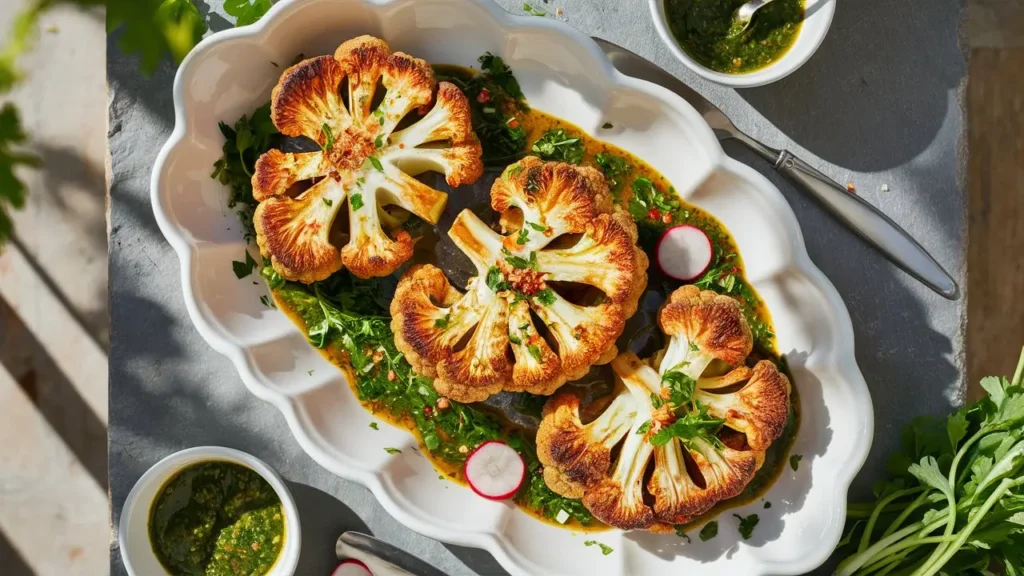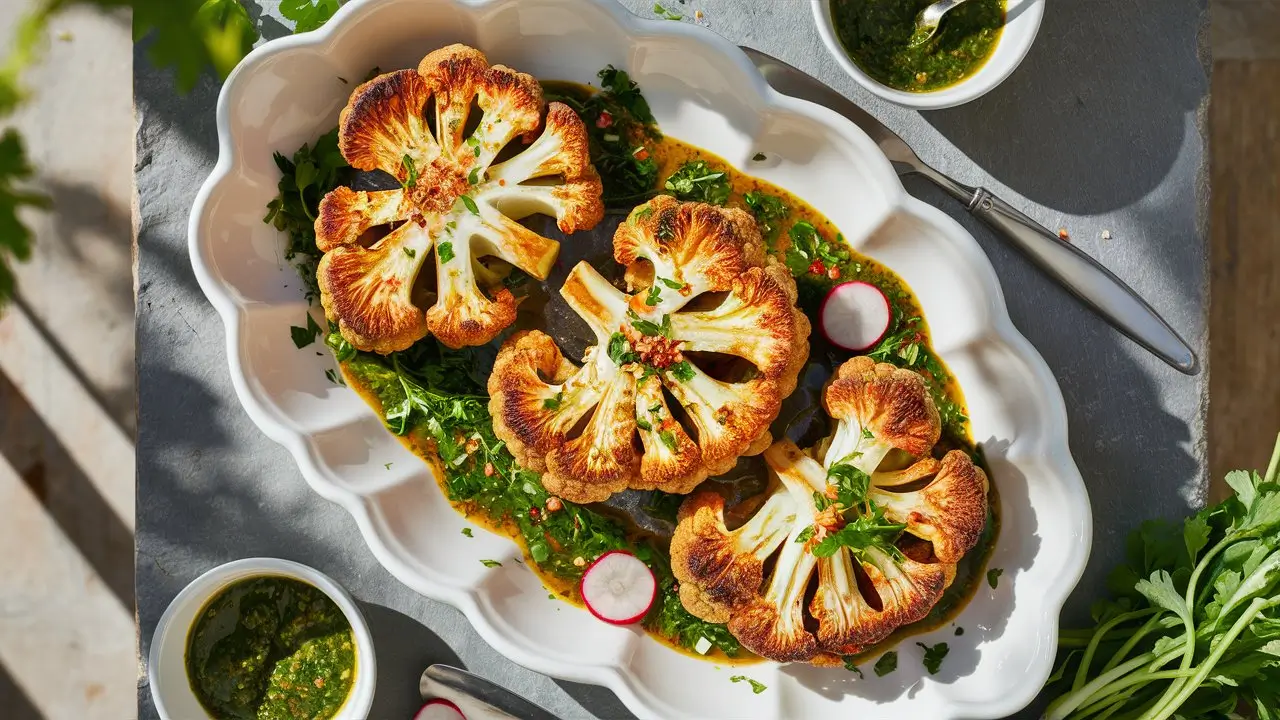If you’ve ever thought of cauliflower as bland or boring, it’s time to change your mind. Roasted cauliflower transforms this humble vegetable into something deeply flavorful, caramelized, and satisfyingly crispy on the outside while tender on the inside. It’s simple to prepare, incredibly versatile, and pairs well with almost any meal.
Why You’ll Love Roasted Cauliflower
-
Easy to Make – Minimal ingredients and effort required.
-
Naturally Healthy – Packed with fiber, vitamins, and antioxidants.
-
Customizable Flavors – From garlic Parmesan to spicy curry.
-
Crispy Texture – Oven-roasting creates caramelized edges and tender centers.
-
Great for Meal Prep – Stores well and works in multiple dishes.
Ingredients List
-
1 large head of cauliflower
-
2–3 tablespoons olive oil
-
1 teaspoon salt
-
½ teaspoon black pepper
-
Optional: garlic powder, paprika, cumin, Parmesan cheese, chili flakes
Optional Flavor Add-Ins:
-
Lemon juice or zest
-
Tahini or yogurt drizzle
-
Fresh herbs (parsley, cilantro, thyme)
Timing and Servings
-
Prep Time: 10 minutes
-
Cook Time: 25–30 minutes
-
Total Time: 35–40 minutes
-
Servings: 4–6 people
How to Roast Cauliflower (Step-by-Step)
Step 1: Preheat the Oven
-
Set your oven to 425°F (220°C) to ensure a nice golden roast.
Step 2: Prepare the Cauliflower
-
Remove the outer leaves and core.
-
Cut into evenly sized florets for uniform cooking.
Step 3: Season the Cauliflower
-
Toss the florets with olive oil, salt, pepper, and any additional seasonings.
-
Ensure each piece is lightly coated for even browning.
Step 4: Spread on a Baking Sheet
-
Arrange in a single layer on a parchment-lined or greased baking sheet.
-
Leave space between florets so they roast, not steam.
Step 5: Roast and Flip
-
Roast for 25–30 minutes, flipping halfway through.
-
Look for golden-brown edges and fork-tender centers.

Flavor Variations to Try
1. Garlic Parmesan Roasted Cauliflower
-
Add 2 cloves minced garlic and ¼ cup grated Parmesan before roasting.
2. Spicy Buffalo Cauliflower
-
Toss roasted florets with buffalo sauce and serve with ranch or blue cheese.
3. Curry-Spiced Cauliflower
-
Add 1 teaspoon curry powder and ½ teaspoon turmeric before baking.
4. Lemon Herb Cauliflower
-
Roast with olive oil and herbs, then finish with lemon zest and juice.
5. Balsamic Roasted Cauliflower
-
Drizzle with balsamic vinegar and honey in the last 5 minutes of roasting.
How to Serve Roasted Cauliflower
Roasted cauliflower is more than a side dish. Try these ideas:
-
As a side – Pairs with roasted meats, fish, pasta, or rice dishes.
-
In a salad – Toss into a grain or green salad for texture.
-
In wraps or bowls – Use in Mediterranean bowls, tacos, or pita wraps.
-
As a snack – Enjoy warm from the oven with a dip like hummus or tahini.
-
As a vegetarian main – Serve over quinoa or lentils with a yogurt drizzle.
Tips for Perfect Roasted Cauliflower
-
Use high heat – Roasting at 425°F caramelizes the edges beautifully.
-
Don’t overcrowd the pan – Give each floret room to roast.
-
Dry the cauliflower – After washing, dry well to avoid steaming.
-
Cut evenly – Uniform size means even cooking.
-
Use enough oil – This helps with browning and prevents dryness.
Nutrition Benefits of Cauliflower
Cauliflower is low in calories but high in nutrients. Here’s why it’s great for you:
-
Rich in fiber – Supports digestion and satiety
-
High in vitamin C – Boosts immune function
-
Contains antioxidants – Fights inflammation
-
Low-carb alternative – Ideal for keto or low-carb diets
-
Versatile for many diets – Vegan, gluten-free, paleo-friendly
Storing and Reheating Roasted Cauliflower
Storage:
-
Store in an airtight container in the refrigerator for up to 4 days.
Reheating:
-
Oven: Reheat at 375°F (190°C) for 10–15 minutes.
-
Air fryer: Crisp up for 5 minutes at 350°F (175°C).
-
Microwave: Reheat in short bursts, but it may lose crispness.
Freezing Roasted Cauliflower
You can freeze roasted cauliflower, but the texture will be softer after thawing.
How to Freeze:
-
Let cool completely, then freeze on a tray before transferring to a bag.
-
Freeze for up to 2 months.
How to Reheat from Frozen:
-
Roast in the oven at 400°F until heated through and edges crisp up.
Creative Ways to Use Leftover Roasted Cauliflower
-
Add to frittatas or omelets
-
Blend into creamy cauliflower soup
-
Mash for a low-carb alternative to mashed potatoes
-
Toss into pasta or risotto
-
Top your pizza or flatbread with it
Common Mistakes to Avoid
-
Overcrowding the pan – Leads to steaming instead of roasting.
-
Not drying the cauliflower – Traps moisture and reduces browning.
-
Skipping the flip – Causes uneven browning.
-
Not seasoning enough – Cauliflower benefits from bold flavors.
-
Undercooking – You want crispy, caramelized edges, not pale florets.
FAQs
Q1: Can I roast frozen cauliflower?
Yes, but you must roast at high heat and expect a softer texture. No need to thaw first.
Q2: Is roasted cauliflower healthy?
Absolutely! It’s nutrient-dense and low in calories, especially if you go light on the oil.
Q3: Why is my roasted cauliflower soggy?
Likely because of overcrowding or too much moisture. Dry florets and space them out.
Q4: Can I use cauliflower stems?
Yes! Slice them thin and roast them along with the florets.
Q5: How do I make it crispy?
High heat, enough oil, and spreading florets in a single layer are key.
Conclusion
Roasted cauliflower is a kitchen essential. It’s easy, nutritious, flavorful, and adaptable to nearly any cuisine. Whether you stick with a basic salt-and-pepper version or get creative with spices and sauces, roasted cauliflower adds warmth, depth, and crunch to your meals.
Try it once, and it’s sure to become a regular on your weekly menu. And once you master the technique, you’ll find countless ways to reinvent it—from spicy side dishes to protein-packed vegetarian mains.
